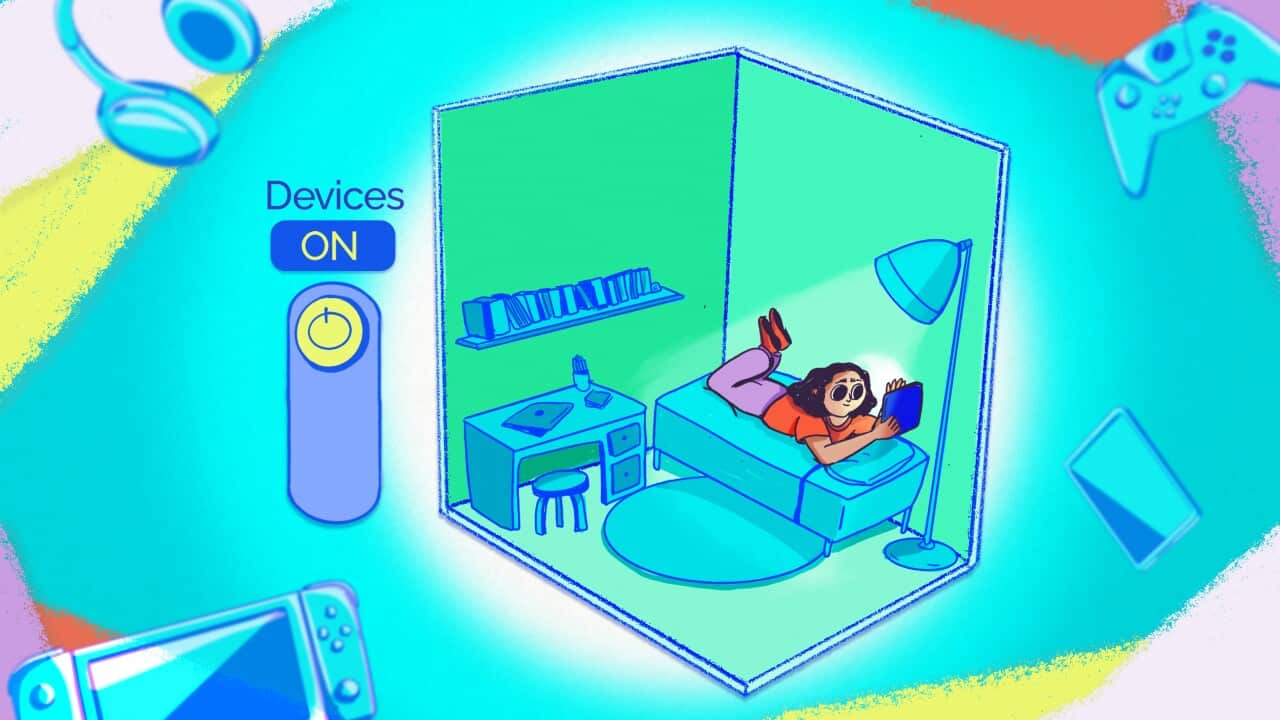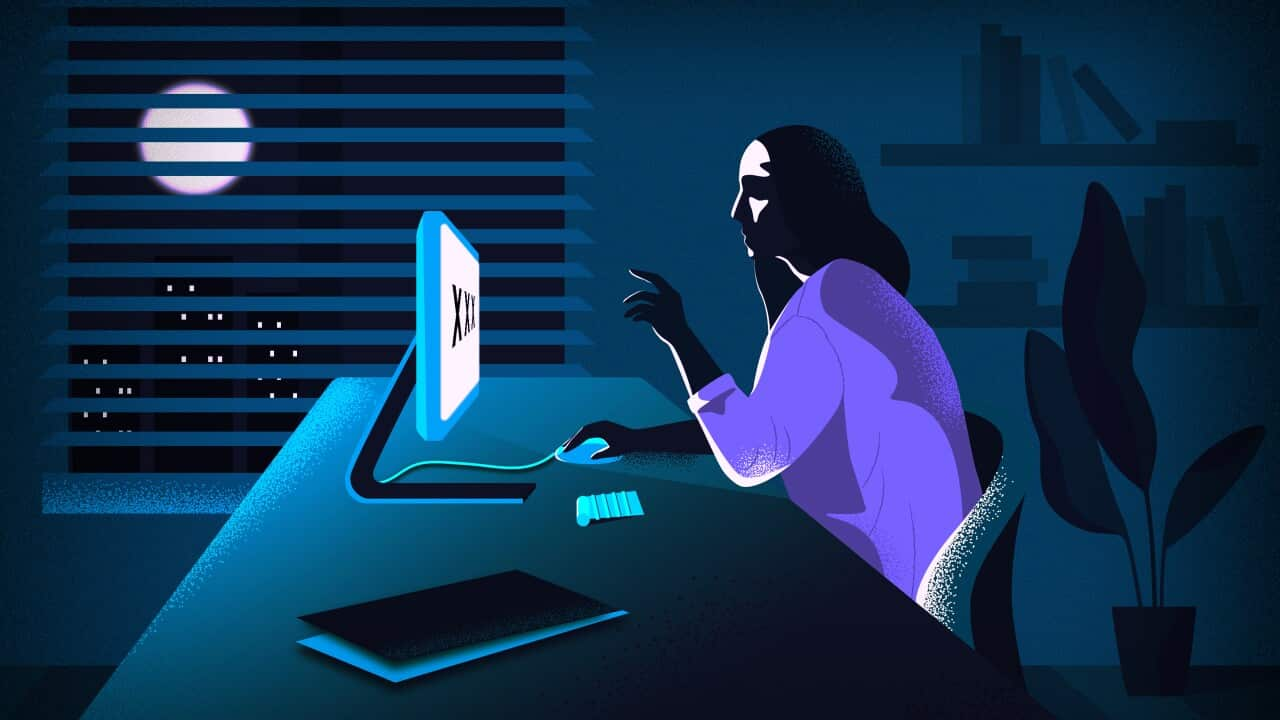Whether you’re too tired to argue or just need 10 minutes to shower, allowing kids screen time is something almost every parent falls back on.
But there is increasing concern about the consequences of the near-universal use of screens among young people.
Data from the Australian National University (ANU) shows 98 per cent of Year 10 students regularly use at least one social media platform, which can adversely impact their life satisfaction.
Parents are increasingly pushing back against screen time for their children, and the Albanese Government says it will introduce a , which has the backing of the state and territory governments.
The World Health Organization has also recognised gaming disorder as a behavioural addiction in its international classification of diseases.
Yet research on the negative impacts of screen use remains inconclusive.
Psychology research fellow Dr Nandi Vijayakumar of Deakin University and the Murdoch Children’s Research Institute explains that existing studies have produced inconsistent results and most have been cross-sectional, meaning they only collect data from a single point in time.
The most consistent evidence seems to be potential negative effects of adolescent social media use on their body image, mental health and wellbeing.
Dr Nandi Vijayakumar, Deakin University
“But the size of this effect is likely to be small when we consider all adolescents,” Vijayakumar says.
Potential risks also seem to differ depending on a child’s age and gender, says Vijayakumar, adding that “some children may struggle with specific types of screen time more than others”.
The ANU’s Generation study found the use of gaming chat platform Discord was associated with the poorest life satisfaction for males, while video-sharing platform TikTok was associated with the poorest life satisfaction for females. But without conclusive evidence on the impacts of screen time, it can be difficult for parents to know how to manage it.
Should you set strict limits on screen time or ban it altogether? And if you do allow your kids screen time, how much is too much?
To better understand the recommended guidelines for kids’ screen use, SBS News has interviewed experts in psychology, paediatrics, media and education.
We’ve taken their advice and turned it into a quiz!
‘Screen time’ vs ‘screen use’
The Australian government provides screen time guidelines on its Department of Health website. The recommendations range from two hours a day for older children to limited use for children under two years.
But the guidelines were developed to promote physical activity for young people — at least three hours a day for toddlers.
Too much screen time can increase sedentary behaviour, giving rise to health issues such as obesity and musculoskeletal problems.
Paediatrician Dr Anthea Rhodes of The Royal Children’s Hospital in Melbourne says setting time limits on screen use can be helpful in managing its risks, and this works best if the rules can be discussed and agreed with children.
Screen use can be a problem for children and young people. Source: SBS News / Rosemary Vasquez-Brown
But Rhodes and other experts are increasingly focusing on screen use when offering advice to parents because it is not just about the number of minutes spent on a device.
She explains: “If the things that they’re viewing have concerning or potentially distressing or upsetting content — violent content for example or explicit content — [they] carry a lot more risk than if a child is viewing something that’s culturally appropriate, educational [or] interactive in some ways.”
Vijayakumar agrees and says educational and interactive content is more likely to have positive impacts on development, if consumed in moderation.
Caution should be used for some video games and social media platforms, which are specifically designed to keep children engaged for long periods, partly through offering rewards such as positive comments or the chance to earn tokens.
“Such constant stimulation can sometimes lead to problematic outcomes and even dependency on these digital experiences,” Vijayakumar says.
The use of social media is also more likely to lead to social comparisons, feelings of being left out and cyberbullying.
“For most kids though, some amount of screen time is okay for their development and health.”
How to limit screen time — and should you?
While setting limits on screen time sounds simple in theory, many parents struggle to enforce these in real life.
Mother-of-four Caroline Maxwell is a lactation consultant who has a background in early childhood education, so she is aware of recommendations for kids’ screen use.
“I’ve seen the negative effect [screen time] has on kids’ behaviour and their sense of self — their self-esteem and their self-motivation,” she says.
Mother-of-four Caroline Maxwell says it can be exhausting enforcing screen time rules. Source: SBS, Supplied / Rosemary Vasquez-Brown
Maxwell’s own children, who range in age from five to 14 years old, are expected to complete certain tasks around the house before they are allowed screen time and must ask her first: There are no screens during meals and no devices after dinner.
She acknowledges that living on a farm in regional NSW, where her children have plenty of space for physical activity, makes it easier to avoid screens, but she still finds it difficult to maintain the rules day in and day out.
Children have a tendency to push boundaries and it can feel exhausting to constantly reinforce rules, she says.
When I’m most tired is [the hardest time to stick to the rules]. I just don’t care anymore [and I’ll say] ‘just go and watch the telly and give me a moment’. It’s the easy option — definitely.
Caroline Maxwell, Mother-of-four
Rhodes, who is also a mother of four, says it’s normal for there to be resistance or difficulty in sticking to rules.
“There is, unfortunately, no silver bullet here. It’s hard work and it’s about trying your best to strike a balance that keeps your young person safe and healthy, whilst acknowledging that digital media use is absolutely part of daily life.”
Young children should not be left alone with devices
Dr Catherine Page Jeffery, a media researcher at the University of Sydney, believes parents shouldn’t be made to feel guilty if they’ve given their baby a screen to play with for half an hour so they can do basic tasks, like take a shower.
“That broader discourse can be quite damaging,” she says.
Even Maxwell, who now has relatively strict rules around screen time, says she occasionally allowed her children to watch TV when they were babies to give her a break. She doesn’t think this has impacted them negatively.
But Pasi Sahlberg, a professor in educational leadership at the University of Melbourne, says very young children should not be given devices — whether it’s an iPad or mobile phone — because they are so addictive.
Certain devices, specific games and social media apps can be particularly addictive. Source: SBS News / Rosemary Vasquez-Brown
Sahlberg is working on the Growing Up Digital Australia study, which aims to understand the impact of digital media on children and youth.
Its 2020 survey found two-thirds of primary school-aged children have smartphones, and that most parents and teachers think digital media and technologies are a growing distraction in children’s lives.
“The use of digital devices at a very young age should come with a very clear purpose,” he says.
“They could be linked to playing some memory games, reading or learning numbers, but with very close supervision of the parents.”
He urges parents to show an interest in what their child is doing in the digital space so that it’s not seen as a “separate universe”.
We should not leave kids by themselves with these devices — or we should limit that to an absolute minimum — and make sure that we care and are curious about what they do and how they feel about those things.
Professor Pasi Sahlberg, University of Melbourne
If a child is reluctant to share their activities, Sahlberg says this could be a sign there is something the parent should know about and discuss with them.
“The earlier we build this type of relationship and expectations with our kids, the more likely it is that that will sustain and continue when they grow older,” he says.
How to tell when screen use is becoming a problem
When assessing whether screen use is becoming an issue, Sahlberg says experts are increasingly looking for signs of problematic interactive media use (PIMU), especially in older children.
This focuses more on the impact of screen use on a child’s behaviour, such as whether they are sleeping properly or displaying obsessive behaviours.
Vijayakumar says emotional irregularities, such as changes in mood or a withdrawal from family and friends, can be red flags and may indicate the young person is experiencing cyberbullying or other stressors related to social media use.
Resistance to putting devices away can be a sign of problematic screen use. Source: SBS, Getty / Rosemary Vasquez-Brown
Anger or difficulty stopping activities such as gaming can reflect a problematic dependency on screens.
Changes to sleeping patterns, such as difficulty falling asleep, as well as difficulty concentrating or a decline in school performance could also be cause for concern.
“But it’s important to recognise that these signs can be reflective of several other factors beyond screen time,” Vijayakumar says.
“Parents should consider the other contexts in their child’s life that may also be contributing to these changes, so they can understand how to best address any potential issues.”
Parents support social media ban but experts are cautious
Many parents, including Maxwell, have welcomed plans to introduce a minimum age for social media access, saying it would make it easier to keep their children off certain apps until they are older.
“I think it’s absolutely brilliant,” Maxwell says.
“I really hope [a ban until] the age of 16 comes in.”
Experts are cautious though and Vijayakumar says it remains unclear whether raising the age of access would reduce potential risks based on current research.
She believes more effort should be put into improving digital literacy as this will help young people navigate social media regardless of when they start using it.
Rhodes agrees and says content that’s concerning for a 14 or 15-year-old could still be concerning for a 16 or 17-year-old — even sometimes for an adult.
Improving digital literacy would help young people to recognise when something is concerning, how to report it, and how to protect their privacy and identity online.
But she says the burden should not rest entirely on young people and their parents — greater onus should be placed on social media platforms to better protect children from harm.
Alternatives to screen time
When trying to find alternatives to screen time, parents should consider the age of their child and why they are engaged with screens, Vijayakumar says.
For younger children, she recommends trying to recreate some of the online activities they enjoy in real life.
“Engaging children in this process and brainstorming together can help distract them and encourage creativity.”
She says adolescents are often interested in connecting with their peers online.
Teenagers place value on interacting with their peers. Source: SBS News / Rosemary Vasquez-Brown
“They might be more receptive to hanging out with their friends in person or participating in extracurricular activities that also involve their friends,” Vijayakumar says.
Maxwell says she has seen the benefits of limiting screen time first-hand.
She once disconnected her household’s only TV for an entire school term and believes it made her kids calmer.
“They were getting probably an hour more sleep … they were reading more … they weren’t fighting or bickering as much,” she says, adding that the only downsides were the extra Lego and toy cars left scattered around the house.
Maxwell says she would love to say “yes” to her kids all the time but she has seen the detrimental impacts of being too permissive, particularly when it comes to screen time.
“Sometimes you just have to say ‘no’ to them — and it’s not always the easiest path.”



















